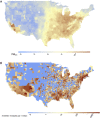Air pollution and COVID-19 mortality in the United States: Strengths and limitations of an ecological regression analysis
- PMID: 33148655
- PMCID: PMC7673673
- DOI: 10.1126/sciadv.abd4049
Air pollution and COVID-19 mortality in the United States: Strengths and limitations of an ecological regression analysis
Abstract
Assessing whether long-term exposure to air pollution increases the severity of COVID-19 health outcomes, including death, is an important public health objective. Limitations in COVID-19 data availability and quality remain obstacles to conducting conclusive studies on this topic. At present, publicly available COVID-19 outcome data for representative populations are available only as area-level counts. Therefore, studies of long-term exposure to air pollution and COVID-19 outcomes using these data must use an ecological regression analysis, which precludes controlling for individual-level COVID-19 risk factors. We describe these challenges in the context of one of the first preliminary investigations of this question in the United States, where we found that higher historical PM2.5 exposures are positively associated with higher county-level COVID-19 mortality rates after accounting for many area-level confounders. Motivated by this study, we lay the groundwork for future research on this important topic, describe the challenges, and outline promising directions and opportunities.
Copyright © 2020 The Authors, some rights reserved; exclusive licensee American Association for the Advancement of Science. No claim to original U.S. Government Works. Distributed under a Creative Commons Attribution NonCommercial License 4.0 (CC BY-NC).
Figures

Update of
-
Exposure to air pollution and COVID-19 mortality in the United States: A nationwide cross-sectional study.medRxiv [Preprint]. 2020 Apr 7:2020.04.05.20054502. doi: 10.1101/2020.04.05.20054502. medRxiv. 2020. Update in: Sci Adv. 2020 Nov 4;6(45):eabd4049. doi: 10.1126/sciadv.abd4049. PMID: 32511651 Free PMC article. Updated. Preprint.
Comment in
-
Environmental justice: What's racism got to do with it?Int J Gynaecol Obstet. 2023 Feb;160(2):372-373. doi: 10.1002/ijgo.14427. Epub 2022 Sep 8. Int J Gynaecol Obstet. 2023. PMID: 36081399 No abstract available.
References
-
- U.S. Environmental Protection Agency (EPA), Integrated Science Assessment (ISA) for Particulate Matter (Final Report, 2019). U.S. Environmental Protection Agency, EPA/600/R-19/188 (2019); https://cfpub.epa.gov/ncea/isa/recordisplay.cfm?deid=347534 [accessed 15 September 2020].
-
- Brook R. D., Rajagopalan S., Arden Pope C. III, Brook J. R., Bhatnagar A., Diez-Roux A. V., Holguin F., Hong Y., Luepker R. V., Mittleman M. A., Peters A., Siscovick D., Smith S. C. Jr., Whitsel L., Kaufman J. D., Particulate matter air pollution and cardiovascular disease: An update to the scientific statement from the American Heart Association. Circulation 121, 2331–2378 (2010). - PubMed
-
- Pope C. A. III, Burnett R. T., Thurston G. D., Thun M. J., Calle E. E., Krewski D., Godleski J. J., Cardiovascular mortality and long-term exposure to particulate air pollution: Epidemiological evidence of general pathophysiological pathways of disease. Circulation 109, 71–77 (2004). - PubMed
-
- Pope C. A. III, Coleman N., Pond Z. A., Burnett R. T., Fine particulate air pollution and human mortality: 25+ years of cohort studies. Environ. Res. 183, 108924 (2020). - PubMed
Publication types
MeSH terms
Grants and funding
LinkOut - more resources
Full Text Sources
Medical

